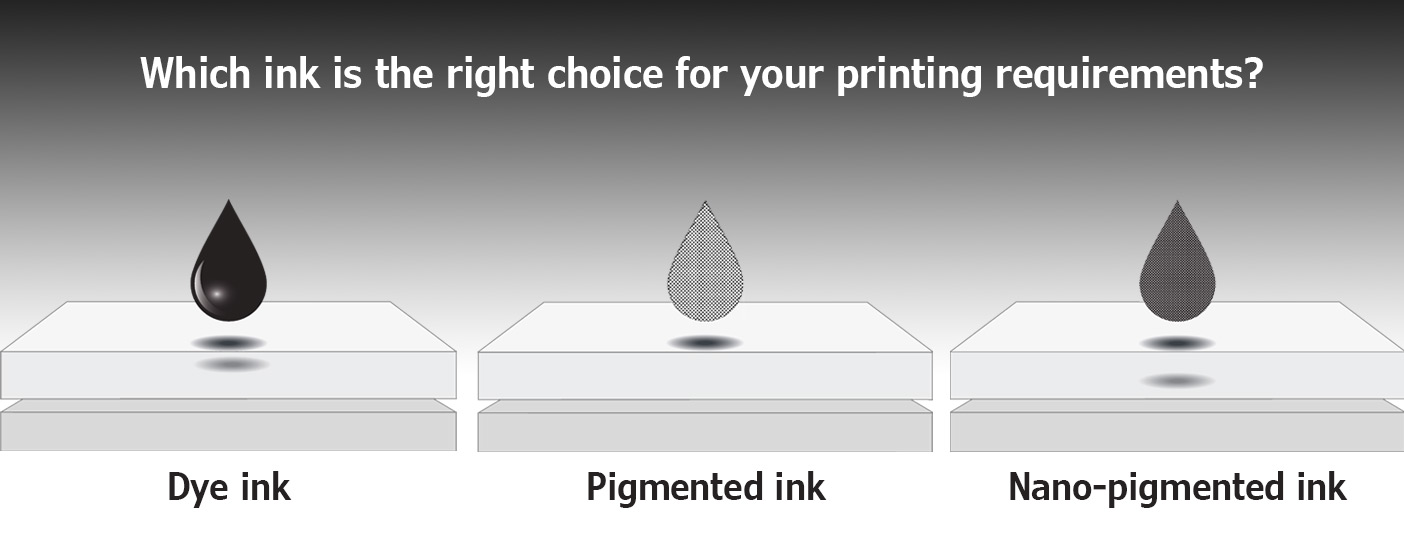The difference between dye, pigmented and nano-pigmented ink
The world of printing technology has made huge advances in recent years, and one of the most important decisions you need to make when choosing a printer or printing method concerns the type of ink you want to use. Dye ink and (nano)pigmented ink are two common options, each with their own advantages and disadvantages. In this blog post, we’ll take a closer look at the difference between these two types of ink to help you decide which is best suited to your individual requirements.
What is dye ink?
Dye ink, also known as dye ink, is a type of ink that uses dye molecules to produce the desired colors. These dyes are usually dissolved in liquid form and are applied to the print medium. Dye ink is often used for full-color and vibrant label printing as it can provide a wide range of colors and excellent color vibrancy. It is also less expensive than pigmented ink.
Advantages and disadvantages of dye ink.
- Advantages:
1) Color brilliance: Dye inks produce vivid and rich colors that look particularly impressive on full-color labels.
2) Smooth transitions: Dye ink can create smooth color gradients and transitions between different color tones.
3) Cost-effective: Dye ink is generally cheaper to produce, which is often reflected in lower printing costs. - Disadvantages:
1) Sensitivity to UV light: Dye inks can fade over time due to exposure to sunlight and UV light, which can lead to a loss of print quality.
2) Water solubility: Dye ink is water soluble, which means that printed materials may be susceptible to smearing or running if they come into contact with moisture.
What is pigmented ink?
Pigmented ink contains tiny solid particles called pigments to create colors. Unlike dyes, these pigments are not dissolved in the liquid but are suspended in the ink. Pigmented ink is often used for commercial labels where durability and resistance to environmental influences are important.
Advantages and disadvantages of pigmented ink.
- Advantages:
1) Light resistance: Pigmented inks are much more resistant to UV light and sunlight, resulting in longer-lasting prints without the colors fading.
2) Water resistance: Pigmented inks are water resistant and do not smudge as easily as dye inks when they come into contact with moisture.
3) Longevity: Prints with pigmented ink can retain their quality and color intensity for decades. - Disadvantages:
1) More expensive: Pigmented ink is often more expensive to produce, which can result in higher printing costs.
2) Reduced color vibrancy: Pigmented inks may not produce the same vivid color vibrancy as dye inks, especially for photo prints.
3) Reduced color vibrancy: Pigmented inks may not produce the same vivid color vibrancy as dye inks, especially for photo prints.
NEW! What is nano-pigmented ink?
Advanced print quality and durability
Nano-pigmented ink is a development in the world of printing technology that further enhances the benefits of traditional pigmented ink through the integration of nanotechnology. This innovative type of ink uses nanoparticles to offer even better print quality, durability and versatility.
What are nanoparticles?
Nanoparticles are tiny particles in the nanometer range (1 nanometer corresponds to one billionth of a meter) that can achieve special effects due to their small size and unique properties. In printing technology, nanoparticles are often used to improve inks and coatings as they are able to change the physical and chemical properties of the materials they come into contact with.
- Properties and advantages of nano-pigmented ink:
1) Improved color brilliance and accuracy: Nanoparticles enable an even distribution of pigments in the ink, resulting in improved color quality and accuracy.
2) Extended color palette: Thanks to precise control over the size and properties of the nanoparticles, printed products can be created with a wider range of colors and tones.
3) Higher resolution: The fine nanoparticles contribute to a higher resolution, allowing details to be printed sharper and clearer.
Faster drying time: Nano-pigmented ink can dry faster than conventional inks, which increases productivity and reduces the risk of smudging.
4) Improved resistance: By using nanoparticles, the pigments can be better bonded to the printing surface, resulting in increased resistance to UV light, water and abrasion.
Conclusion:
The choice between dye ink and (nano)pigmented ink depends on your individual requirements and preferences. If you need vivid colors and photo prints, dye ink might be the right choice. However, if resistance to environmental influences and longer durability of your prints are important, pigmented ink might be the better option. It’s also important to consider the intended use of your prints, budget and desired durability before making a decision.



